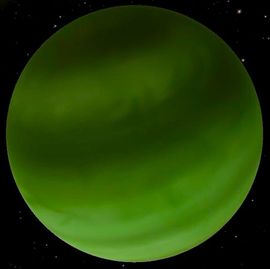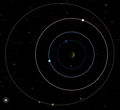Difference between revisions of "Jool/zh-cn"
m (-usage of /Data pages;) |
|||
| (22 intermediate revisions by 3 users not shown) | |||
| Line 1: | Line 1: | ||
| − | {{ | + | {{Infobox/Body}} |
| − | '''Jool'''是一颗[[w:Gas giant|气态巨行星]],是 [[Kerbol]] 星系中的第六颗行星。它实际上就是 Kerbal 太空计划中的[[w:Jupiter|木星]]。除 Kerbol | + | '''Jool''' 是一颗[[w:Gas giant|气态巨行星]],是 [[Kerbol/zh-cn|Kerbol]] 星系中的第六颗行星。它实际上就是 Kerbal 太空计划中的[[w:Jupiter|木星]]。除 Kerbol 之外,在该星系的所有天体中,Jool 的直径和质量都排名第一。虽然它距离 [[Kerbin/zh-cn|Kerbin]] 很远,难以到达,它还是因为其自身复杂的五卫星体系成为极富吸引力的航天探索目标,它的五颗卫星包括:'''[[Laythe/zh-cn|Laythe]]'''、'''[[Vall/zh-cn|Vall]]'''、'''[[Tylo/zh-cn|Tylo]]'''、'''[[Bop/zh-cn|Bop]]''' 和 '''[[Pol/zh-cn|Pol]]'''。 |
| − | == | + | == 大气层 == |
{| | {| | ||
| | | | ||
| − | [[File:JoolAtmosphere.png|thumb|right| | + | [[File:JoolAtmosphere.png|thumb|right|Jool 大气层中的大气制动。]] |
| − | + | 尽管 Jool 的半径是 Kerbin 的十倍,它的[[atmosphere|大气层]]高度只有 Kerbin 的两倍(138.2 km)。它异常稠密,非常适合行星际高速转移任务的[[aerobraking|大气制动]]。其大气层外最低轨道的周期为 94.7437 分钟,速度为 6,785 m/s。进行大气制动飞行时,通常没必要进入 100 km 轨道高度之下。 | |
| − | + | 总之,Jool 的气压与高度(米)的关系为: | |
: <math>p_j = 15\ e^{-altitude/10000}</math> | : <math>p_j = 15\ e^{-altitude/10000}</math> | ||
| − | [[File:Kerbal_landing_on_jool.png|thumb|left| | + | [[File:Kerbal_landing_on_jool.png|thumb|left|Kerbal 航天员在 Jool “表面” 着陆的后果]] |
| − | + | 靠近行星表面时,游戏的物理模型会完全失效。由于其极其稠密的大气层,终点速度会降得很低,所以轻型飞船的降落根本不需要降落伞或反推火箭。Jool 的表面没有固态区域可供着陆,飞船最终的命运都是被 [[Kraken]] 吞噬。如果飞船很小,它或许可以从 Kraken 逃脱,但落至表面 100m 以下时,组件会爆炸。你会在任务概述中看到诸如“……与云相撞”之类的信息。 | |
| − | + | Kerbin 航天员可以通过 EVA 安全登陆 Jool,不过这只是一趟无法回头的单程旅行。你可以在[http://www.youtube.com/watch?v=Kkeb5-u3-lY 这个视频]的最后看到,小绿人无法控制的抖动变形。不过这只会在 4x 的时间压缩下才能看到。这时游戏会退出,黑屏,高度表快速的变化显示数字。随后,Kerbin 的大气层会莫名消失,只有重启游戏才能让它恢复正常。 | |
| − | |} | + | |} 这个奇特的现象,通常都在 Jool 上发生,不过倒也不是只能在那儿。其实在 Kerbin 的某些极端情况下也会出现;例如,从高速飞行起飞的太空飞机上进行 EVA 有时也会出现这一奇景。在 Jool 之外遇到这个现象,其实是很难复制的,所以很少能看到相应的视频。 |
| − | == | + | == 参考系 == |
{{:Jool/RefFrame}} | {{:Jool/RefFrame}} | ||
| − | == | + | == 天然卫星 == |
{| | {| | ||
| | | | ||
| − | [[File:JoolLaythe.png|thumb|right| | + | [[File:JoolLaythe.png|thumb|right|大片海洋覆盖的月亮,[[Laythe/zh-cn|Laythe]],我们即将观察到它的凌 Jool 现象。]] |
| − | Jool | + | Jool 有五颗天然卫星,每个卫星的轨道平面都和 Jool 自身的轨道平面相重合: |
| − | * '''[[Laythe]]''' | + | * '''[[Laythe/zh-cn|Laythe]]''',一个被大片海洋覆盖的月球,它是唯一一颗拥有大气层的卫星。它距离 Jool 最近,在所有卫星中大小排名第二。由于它的高轨道速度,登陆 Laythe 非常具有挑战性。在 Kerbal 星系中,就天体的体积和组成成分而言,Laythe 与 [[Kerbin/zh-cn|Kerbin]] 的相似程度仅次于 [[Eve/zh-cn|Eve]]。 |
| − | * '''[[Vall]]''' | + | * '''[[Vall/zh-cn|Vall]]''',一个冰封的月球,体积排名第三,与 Jool 的远近程度居于次席。它的轨道和速度正好处于 Laythe 与 Tylo 的正中间。 |
| − | * '''[[Tylo]]''' | + | * '''[[Tylo/zh-cn|Tylo]]''',一个岩石覆盖的月球,重力与 [[Kerbin/zh-cn|Kerbin]] 类似,而地形接近于 Kerbin 的卫星 [[Mun/zh-cn|Mun]]。在所有 Jool 的卫星中,其 SOI 最大,所以被它的引力捕获,但同样是因为它巨大的引力范围,同时它又缺乏大气层,Tylo 的入轨和登陆任务都是非常困难的。 |
| − | * '''[[Bop]]''' | + | * '''[[Bop/zh-cn|Bop]]''',一颗被 Jool 捕获的小行星,是第四大的 Jool 卫星。因为其轨道距离远,不规则,而且其重力偏低,登陆 Bop 也是一个极富挑战性的任务。 |
| − | * '''[[Pol]]''' | + | * '''[[Pol/zh-cn|Pol]]''',它的命名是因为其外形近似花粉,Jool 卫星中最小的一颗,也是最遥远的一颗。它的外观是黄绿色交杂,遍布岩石,地形崎岖不平,耸立着陡峭的高山。 |
| − | + | Laythe、Vall和Tylo三者的轨道符合拉普拉斯共振,轨道周期比为1:2:4。 | |
| − | + | Jool 卫星的同步轨道是不存在的,因为理论的轨道已经处于各个卫星的作用范围之外,这是同步自传天体常见的现象。 | |
|} | |} | ||
| − | == | + | == 图册 == |
<gallery> | <gallery> | ||
| − | Jool_Descent.png | | + | Jool_Descent.png | 进入 Jool 大气层的探测器,最终由于高压损毁。 |
| − | Jool.png | | + | Jool.png | 0.17 里的 Jool。 |
| − | jool_and_moons.jpg | | + | jool_and_moons.jpg | 0.17 里的 Jool 和其卫星。 |
| − | + | Jool low orbit.png | Jool 的低轨运行。 | |
| − | + | Winged probe around Jool.png | 带有气动控制小翼的探测器。在 Jool 大气层下降到更低的高度后,飞行器的机动会变得极其困难,无论是 RCS 、气动控制小翼都无法发挥作用。 | |
| − | + | Jool aerobraking with moons.png | 在 Jool 进行空气制动时拍摄下的 Laythe、Vall 和 Tylo。 | |
| − | 19Aerobrake.jpg | | + | 19Aerobrake.jpg | 0.19,一颗探测器在 Jool 大气层进行空气制动时的图片,在背景可以看到 Laythe、Tylo 和 Vall 。在探测器损毁前,空气制动进行了大约 15 分钟。 |
| − | Joolstation.png | | + | Joolstation.png | 0.20 中,围绕 Jool 飞行的小型空间站。 |
</gallery> | </gallery> | ||
| − | == | + | == 花絮 == |
| − | * Jool | + | * Jool 的赤道半径相当于实际的地球和金星; |
| − | * | + | * Jool 上的日出和日落看起来一片黄褐色的阴影; |
| − | * | + | * 和 Jool 一样,木星最近的三颗卫星(Io、Europa 和 Ganymede),其轨道也处于拉普拉斯共振,即周期比例为 1:2:4; |
| − | == | + | == 更新 == |
;{{Version|0.18|}} | ;{{Version|0.18|}} | ||
| − | * | + | * 增加一颗新的卫星,距离更遥远,命名为 Pol。 |
;{{Version|0.17|}} | ;{{Version|0.17|}} | ||
| − | * | + | * 最初加入 |
{{Celestial Bodies}} | {{Celestial Bodies}} | ||
| − | [[Category:Celestials]] | + | [[Category:Celestials/zh-cn]] |
| − | [[Category:Planets]] | + | [[Category:Planets/zh-cn]] |
Revision as of 03:15, 25 December 2014
| Jool | ||
| 从轨道上看Jool。 | ||
| 行星 绕转于 Kerbol | ||
| 轨道特征 | ||
| 半长轴 | 68 773 560 320 米 [Note 1] | |
| 远拱点 | 72 212 238 387 米 [Note 1] | |
| 近拱点 | 65 334 882 253 米 [Note 1] | |
| 轨道离心率 | 0.05 | |
| 轨道倾角 | 1.304 ° | |
| 近心点辐角 | 0 ° | |
| 升交点经度 | 52 ° | |
| 平近点角 | 0.1 rad (在 0秒 时钟) | |
| 轨道周期 | 104 661 432 秒 | |
| 4 845 d 2 h 37 m 12.1 s | ||
| 会合周期 | 10 090 901.7 秒 | |
| 轨道速度 | 3 927 - 4 341 米/秒 | |
| 物理特征 | ||
| 赤道半径 | 6 000 000 米 | |
| 赤道周长 | 37 699 112 米 | |
| 表面积 | 4.5238934×1014 米2 | |
| 质量 | 4.2332127×1024 千克 | |
| 标准重力参数 | 2.8252800×1014 米3/秒2 | |
| 密度 | 4 678.7273 千克/米3 | |
| 表面重力加速度 | 7.85 米/秒2 (0.8 克) | |
| 宇宙速度 | 9 704.43 米/秒 | |
| 自转周期 | 36 000.000 秒 | |
| 1 d 4 h 0 m 0 s | ||
| 太阳日 | 36 012.387 秒 | |
| 1 d 4 h 0 m 12.4 s | ||
| 恒星旋转速度 | 1 047.2 米/秒 | |
| 同步轨道高度 | 15 010.46 千米 | |
| 引力作用距离 | 2.4559852×109 米 [Note 1] | |
| 大气特征 | ||
| 存在大气层 | 是 | |
| 海平面大气压强 | 1 519.88 千Pa | |
| 15 标准大气压 | ||
| 大气上限高度 | 200 000 米 | |
| 1.5×10-5 标准大气压 | ||
| 大气温度(最低) | -153.14 °C 120.01 开尔文 | |
| 大气温度(最高) | -48.08 °C 225.07 开尔文 | |
| 存在氧气 | 否 | |
| 科研倍率 | ||
| 地表 | N/A | |
| 溅落 | N/A | |
| 低层大气 | 12 | |
| 高层大气 | 9 | |
| 太空(近处) | 7 | |
| 太空(远处) | 6 | |
| 回收 | 6 | |
|
| ||
Jool 是一颗气态巨行星,是 Kerbol 星系中的第六颗行星。它实际上就是 Kerbal 太空计划中的木星。除 Kerbol 之外,在该星系的所有天体中,Jool 的直径和质量都排名第一。虽然它距离 Kerbin 很远,难以到达,它还是因为其自身复杂的五卫星体系成为极富吸引力的航天探索目标,它的五颗卫星包括:Laythe、Vall、Tylo、Bop 和 Pol。
大气层
|
尽管 Jool 的半径是 Kerbin 的十倍,它的大气层高度只有 Kerbin 的两倍(138.2 km)。它异常稠密,非常适合行星际高速转移任务的大气制动。其大气层外最低轨道的周期为 94.7437 分钟,速度为 6,785 m/s。进行大气制动飞行时,通常没必要进入 100 km 轨道高度之下。 总之,Jool 的气压与高度(米)的关系为: 靠近行星表面时,游戏的物理模型会完全失效。由于其极其稠密的大气层,终点速度会降得很低,所以轻型飞船的降落根本不需要降落伞或反推火箭。Jool 的表面没有固态区域可供着陆,飞船最终的命运都是被 Kraken 吞噬。如果飞船很小,它或许可以从 Kraken 逃脱,但落至表面 100m 以下时,组件会爆炸。你会在任务概述中看到诸如“……与云相撞”之类的信息。 Kerbin 航天员可以通过 EVA 安全登陆 Jool,不过这只是一趟无法回头的单程旅行。你可以在这个视频的最后看到,小绿人无法控制的抖动变形。不过这只会在 4x 的时间压缩下才能看到。这时游戏会退出,黑屏,高度表快速的变化显示数字。随后,Kerbin 的大气层会莫名消失,只有重启游戏才能让它恢复正常。 |
参考系
| 时间加速 | 最低海拔 |
|---|---|
| 1× | 所有 |
| 5× | 200 000 米 (高于大气上限) |
| 10× | 200 000 米 (高于大气上限) |
| 50× | 200 000 米 (高于大气上限) |
| 100× | 200 000 米 (高于大气上限) |
| 1 000× | 300 000 米 |
| 10 000× | 600 000 米 |
| 100 000× | 1 200 000 米 |
天然卫星
 大片海洋覆盖的月亮,Laythe,我们即将观察到它的凌 Jool 现象。 Jool 有五颗天然卫星,每个卫星的轨道平面都和 Jool 自身的轨道平面相重合:
Laythe、Vall和Tylo三者的轨道符合拉普拉斯共振,轨道周期比为1:2:4。 Jool 卫星的同步轨道是不存在的,因为理论的轨道已经处于各个卫星的作用范围之外,这是同步自传天体常见的现象。 |
图册
花絮
- Jool 的赤道半径相当于实际的地球和金星;
- Jool 上的日出和日落看起来一片黄褐色的阴影;
- 和 Jool 一样,木星最近的三颗卫星(Io、Europa 和 Ganymede),其轨道也处于拉普拉斯共振,即周期比例为 1:2:4;
更新
- 增加一颗新的卫星,距离更遥远,命名为 Pol。
- 最初加入











